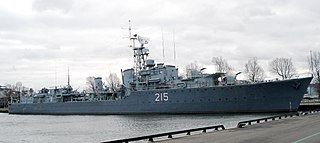
HMCS Haida is a Tribal-class destroyer that served in the Royal Canadian Navy (RCN) from 1943 to 1963, participating in World War II and the Korean War. She was named after the Haida people.

HMCS Toronto is a Halifax-class frigate that has served in the Canadian Forces since 1993. Toronto is the fourth ship in her class which is the name for the Canadian Patrol Frigate Project. She is the second RCN ship to be named for Canada's largest city. When not on operations she is assigned to Maritime Forces Atlantic (MARLANT) and is based at CFB Halifax. Toronto serves on MARLANT missions protecting Canada's sovereignty in the Atlantic Ocean and enforcing Canadian laws in its territorial sea and exclusive economic zone.
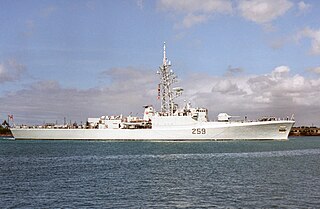
HMCS Terra Nova was a Restigouche-class destroyer that served in the Royal Canadian Navy and later the Canadian Forces from 1959 until 1997. After her final refit, she was a guided missile destroyer.
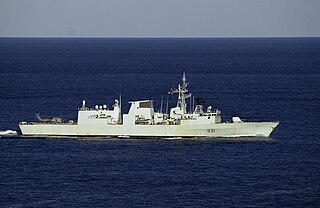
HMCS Vancouver is a Halifax-class frigate, of the Royal Canadian Navy launched on 8 July 1989, as the second vessel of her class. She is based at CFB Esquimalt on the west coast of Canada, and is the third vessel to be named after Vancouver, British Columbia.

The AN/SPG-51 is an American tracking / illumination fire-control radar for RIM-24 Tartar and RIM-66 Standard missiles. It is used for target tracking and Surface-to-air missile guidance as part of the Mk. 73 gun and missile director system, which is part of the Tartar Guided Missile Fire Control System.

HMCS Regina is a Halifax-class frigate that has served in the Canadian Forces and Royal Canadian Navy since 1993. Regina is the fifth vessel in her class which is the name for the Canadian Patrol Frigate Project. She is the second vessel to carry the designation HMCS Regina. She is assigned to Maritime Forces Pacific (MARPAC) and is homeported at CFB Esquimalt.

HMCS Mackenzie was a Mackenzie-class destroyer that served in the Royal Canadian Navy (RCN) and later the Canadian Forces. She was the lead ship of her class and is the first Canadian naval unit to carry this name. The ship was named for the Mackenzie River, the largest river system in Canada and runs primarily through the Northwest Territories.
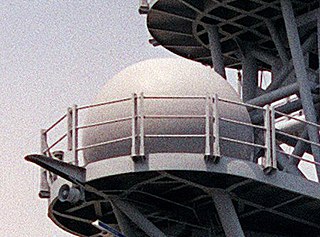
AN/SPQ-9A is a United States Navy multi-purpose surface search and fire control radar used with the Mk-86 gun fire-control system. It is a two dimensional surface-search radar, meaning it provides only range and bearing but not elevation. It is intended primarily to detect and track targets at sea level, on the surface of the water for either gun fire engagement or navigation. It can however, also detect and track low altitude air targets.

HMCS Kootenay was a Restigouche-class destroyer escort that served in the Royal Canadian Navy and Canadian Forces from 1959 until 1996. She was the fifth ship in her class and the second vessel to carry the designation HMCS Kootenay. The ship suffered two serious incidents in her career: a 1969 explosion and ensuing fire that killed nine, and a 1989 collision that required the complete replacement of her bow. Following her service, the ship was sunk as an artificial reef.

HMCS Saskatchewan was a Mackenzie-class destroyer that served in the Royal Canadian Navy (RCN) and later the Canadian Forces. She was the second Canadian naval unit to bear the name HMCS Saskatchewan. The ship was named for the Saskatchewan River which runs from Saskatchewan to Manitoba in Canada.

The Annapolis-class destroyer escort was a two-ship class of destroyer escorts that saw service with the Royal Canadian Navy and Canadian Forces from the 1960s to the 1990s. The final version of the St. Laurent-class design, the class was used extensively for anti-submarine warfare purposes. Both ships were sunk as artificial reefs after being retired, one on each coast of Canada.

HMCS Gatineau was a Restigouche-class destroyer that served in the Royal Canadian Navy and later the Canadian Forces during the Cold War from 1959 to 1996. She was the third ship in her class and the second vessel to carry the designation HMCS Gatineau. She was sold for scrapping in 2009.

HMCS St. Croix was a Restigouche-class destroyer that served in the Royal Canadian Navy and later the Canadian Forces from 1958 to 1974. The fourth ship commissioned in the class, she was the second ship to bear the name. Following her decommissioning, the ship was used as a training ship at Halifax, Nova Scotia until 1991, when St. Croix was sold for scrapping.

The AN/SPG-60 is a United States tracking radar that is part of the MK-86 Gun Fire Control System (GFCS). It is used for air tracking and on some MK-86 configurations it is also used for illumination for RIM-24 Tartar and RIM-66 Standard missiles. Though the radar is primarily an air tracking radar, the SPG-60 radar can be used for surface tracking. With the boresight mounted camera, the radar could also be used as a sight for optical tracking, optical engagement and damage assessment.
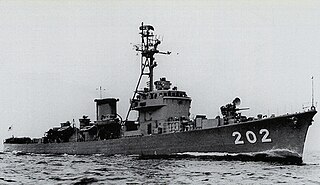
JDS Ikazuchi (DE-202) is the lead ship of Ikazuchi-class destroyer escort of Japan Maritime Self-Defense Force.

JDS Inazuma (DE-203) is the second ship of the Ikazuchi-class destroyer escorts of the Japan Maritime Self-Defense Force (JMSDF).

JDS Isuzu (DE-211) is the lead ship of the Isuzu-class destroyer escorts of the Japan Maritime Self-Defense Force (JMSDF).

JDS Mogami (DE-212) is the second ship of Isuzu-class destroyer escort of Japan Maritime Self-Defense Force (JMSDF).

OPS-18 is a two-dimensional radar manufactured by Japan Radio Company. It is installed as an anti-water search radar on the Maritime Self-Defense Force's escort ship. Variations include OPS-18-1 and OPS-18-3.

Mark 56 Gun Fire Control System is a gun fire-control system made up of AN/SPG-35 radar tracker and the Mark 42 ballistic computer.























